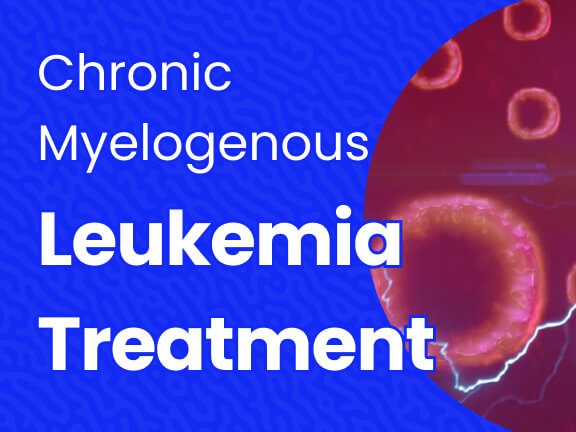Chronic myelogenous leukemia (CML) is a slow-progressing blood and bone marrow disease that mainly affects people in their forties or fifties, with children being the exception. Too many blood stem cells in CML turn into granulocytes, a type of white blood cell. These granulocytes are aberrant white blood cells that do not mature into healthy white blood cells. They’re also referred to as leukemia cells. Leukemia cells can accumulate in the blood and bone marrow, making it difficult for healthy white blood cells, red blood cells, and platelets to thrive. Infection, anemia, or easy bleeding may result because of this.
General Information About Chronic Myelogenous Leukemia
The term “chronic” alludes to the fact that chronic myelogenous leukemia advances more slowly than acute leukemia. Chronic myelogenous leukemia affects the type of cells known as myelogenous cells.
CML is also known as chronic myeloid leukemia and chronic granulocytic leukemia. It primarily affects the elderly and only occasionally teens, however, it can afflict anyone at any age.
People with chronic myelogenous leukemia now have a significantly better prognosis as a result of therapy breakthroughs. The vast majority of people will go into remission after being diagnosed and will live for many years.
Stages of Chronic Myelogenous Leukemia
There are three stages to chronic myelogenous leukemia.
There is less room for healthy white blood cells, red blood cells, and platelets as the number of blast cells in the blood and bone marrow increases. Infections, anemia, and easy bleeding are possible adverse effects, such as bone discomfort and a feeling of fullness below the ribs on the left side. The phase of the disease is determined by the quantity of blast cells in the blood and bone marrow, as well as the severity of signs and symptoms.
Chronic phase
Blast cells make up less than 10 percent of the blood and bone marrow cells in chronic phase CML.
Accelerated phase
Blast cells make up about 10 percent to 19 percent of the cells in the blood and bone marrow in accelerated phase CML.
Blastic phase
Blast cells make up 20 percent or more of the cells in the blood or bone marrow during the blastic phase of CML. Blast crisis occurs when weariness, fever, and an enlarged spleen occur during the blastic phase.
Detection and Diagnosis of Chronic Myelogenous Leukemia

Tests that examine the blood and bone marrow are used to diagnose chronic myelogenous leukemia.
The following tests and procedures may be used:
Physical exam and health history: An examination of the body to look for general indicators of health, as well as signs of sickness such an enlarged spleen. In addition, a history of the patient’s health habits, as well as previous diseases and treatments, will be collected.
Complete blood count (CBC) with differential: A method that involves drawing a sample of blood and testing it for the following:
- The number of red blood cells and platelets in a person’s blood.
- The quantity and type of white blood cells in the body.
- The amount of hemoglobin (an oxygen-carrying protein) in red blood cells.
- Red blood cells make up the majority of the blood sample.
Blood chemistry studies: A blood sample is tested to determine the levels of specific compounds released into the blood by the body’s organs and tissues. An abnormal amount of material (greater or lower than normal) might be a symptom of sickness.
Bone marrow aspiration and biopsy: A needle is inserted into the hipbone or breastbone to remove bone marrow, blood, and a small piece of bone. A pathologist uses a microscope to examine the bone marrow, blood, and bone for abnormal cells.
How is Chronic Myelogenous Leukemia Treated?
Six types of standard treatment are used:
Targeted therapy is a method of cancer treatment that involves use of targeted medicines or other chemicals to target and kill specific cancer cells. Targeted therapies are less likely than chemotherapy or radiation therapy to kill normal cells.
- Tyrosine kinase inhibitor therapy: This medication inhibits tyrosine kinase, an enzyme that allows stem cells to divide and produce more white blood cells (blasts) than the body requires. Tyrosine kinase inhibitors such as imatinib mesylate (Gleevec), dasatinib, nilotinib, ponatinib, and bosutinib are used to treat CML.
Chemotherapy is a cancer treatment that employs medications to stop cancer cells from growing by killing or preventing them from dividing. Chemotherapy medications enter the bloodstream and can reach cancer cells all throughout the body when taken by mouth or injected into a vein or muscle (systemic chemotherapy).
Immunotherapy is a treatment that uses the patient’s immune system to fight cancer. Substances made by the body or made in a laboratory are used to boost, direct, or restore the body’s natural defenses against cancer. This cancer treatment is a type of biologic therapy.
Stem cell transplant: Blood is drawn from a vein in the donor’s arm. The donor could be the patient or someone else. The blood is pumped through a machine that separates the stem cells from the rest of the blood. The blood is then returned to the donor via a vein in the opposite arm. Chemotherapy is given to the patient in order to kill blood-forming cells. Radiation therapy may be administered to the patient. A catheter is inserted into a blood artery in the patient’s chest to deliver stem cells.
Donor lymphocyte infusion (DLI) is a cancer treatment that can be used in conjunction with a stem cell transplant. The stem cell transplant donor’s lymphocytes (a kind of white blood cell) are extracted from the donor’s blood and may be frozen for preservation. If the donor’s lymphocytes were frozen, they were thawed before being delivered to the patient via one or more infusions. The lymphocytes mistake the cancer cells in the patient for foreign invaders and attack them.
Surgery
Splenectomy is surgery to remove the spleen.
Clinical Trials for Chronic Myelogenous Leukemia
Chronic myelogenous leukemia clinical trials offer access to novel, cutting-edge treatments that aren’t generally available but go through rigorous FDA-authorized regulatory processes before being licensed for use. Clinical trials are one option to acquire cutting-edge cancer treatment, and they may be the only route to get innovative medications in some circumstances. They are also the most effective approach for doctors to learn new cancer treatment methods. Using our AI-powered approach, Massive Bio leads patients through the most extensive clinical trial matching process available.
We can assist you if you have been diagnosed with any of the following myelofibrosis subtypes:
- Primary Myelofibrosis (also known as chronic idiopathic myelofibrosis)
- Chronic Myelogenous Leukemia
- Polycythemia Vera
- Essential Thrombocythemia
- Chronic Neutrophilic Leukemia
- Chronic Eosinophilic Leukemia
If you do not know which type of myelofibrosis you have, that is okay. Additional testing can help you determine your exact diagnosis.
Sources:




